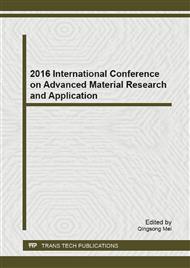[1]
A.K. Garbuzova, V.V. Rudneva, G.V. Galevsky, L.S. Shiryaeva, Analysis of current condition of fabrication and application of titanium carbide, J. Reporter of Siberian State Industrial University. 1 (2014) 58 – 66.
Google Scholar
[2]
L. Takacs, What is unique about mechanochemical reactions? Acta Physica Polonica A. 126 (2014) 1040–1043.
DOI: 10.12693/aphyspola.126.1040
Google Scholar
[3]
C. Kajdas, Mechanical activation of chemical process, Materials Sciences and Applications. 6 (2015) 60–67.
Google Scholar
[4]
A.A. Popovich, Microstructure and properties of titanium carbide and titanium carbide-based alloys obtained by tribochemical synthesis, Journal of Alloys and Compounds. 196 (1993) 97–104.
DOI: 10.1016/0925-8388(93)90577-a
Google Scholar
[5]
A.A. Popovich, V.P. Reva, V.N. Vasilenko, T.A. Popovich and O.A. Belous, Mechanochemical method for obtaining powders of refractory compounds, Poroshkovaya Metallurgiya. 2 (1993) 37–43.
DOI: 10.1007/bf00560037
Google Scholar
[6]
A.A. Popovich, V.P. Reva , T.A. Popovich and O.V. Arestov, Kinetics and structure of refractory compounds and alloys obtained by mechanical alloying, Journal of Materials Science and Technology. 17 (1) (2001) 63-64.
Google Scholar
[7]
D.V. Onishchenko and V. P. Reva, Creation of Useful Carbon Materials from Plants, Coke and Chemistry. 55 (5) (2012) 192–196.
DOI: 10.3103/s1068364x12050079
Google Scholar
[8]
V.P. Reva, D.V. Onishchenko, Features of mechanochemical synthesis of tungsten and titanium carbides with participation of natural graphite, Refractories and Industrial Ceramics. 53 (5) (2013) 330-334.
DOI: 10.1007/s11148-013-9521-y
Google Scholar
[9]
G.A. Dorofeev, V.I. Ladjanov, A.N. Lubnin, F.Z. Gilmutdinov, E.V. Kuzminykh and S.M. Ivanov, Initial stage of mechanochemical synthesis in the Ti-C exothermic system, Bulletin of the Russian Academy of Sciences: Physics. 75 (11) (2011) 1427-1434.
DOI: 10.3103/s1062873811110086
Google Scholar
[10]
M.B. Rahaei, R. Yazdani rad, A. Kazemzadeh, T. Ebadzadeh, Mechanochemical synthesis of nano TiC powder by mechanical milling of titanium and graphite powders, Powder Technology. 217 (2012) 369–376.
DOI: 10.1016/j.powtec.2011.10.050
Google Scholar
[11]
B. Li, L. Cui, Y. Zheng and C. Xu, Synthesis of TiC powder by mechanical alloying of titanium and asphalt, Chinese Journal of Chemical Engineering. 15 (1) (2007) 138–140.
DOI: 10.1016/s1004-9541(07)60047-0
Google Scholar
[12]
M.E. Mullins and E. Riley, The effect of carbon morphology on the combustion synthesis of titanium carbide, Journal of Materials Research. 4 (2) (1989) 408–411.
DOI: 10.1557/jmr.1989.0408
Google Scholar


